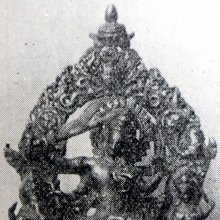Ganapati, Gaṇapati, Gana-pati: 24 definitions
Introduction:
Ganapati means something in Buddhism, Pali, Hinduism, Sanskrit, Jainism, Prakrit, the history of ancient India, Marathi. If you want to know the exact meaning, history, etymology or English translation of this term then check out the descriptions on this page. Add your comment or reference to a book if you want to contribute to this summary article.
Ganapati has 22 English definitions available.
Images (photo gallery)
(+18 more images available)
Languages of India and abroad
Sanskrit dictionary
[Deutsch Wörterbuch]
Source: Cologne Digital Sanskrit Dictionaries: Böhtlingk and Roth Grosses Petersburger WörterbuchGaṇapati (गणपति):—(gaṇa + pati) m. gaṇa aśvapati zu [Pāṇini’s acht Bücher 4, 1, 84.]
1) Schaarführer, Oberster des Haufens [Vājasaneyisaṃhitā 16, 25. 22, 30. 23, 19.] Bṛhaspati [Ṛgveda 2,23, 1.] Indra [10, 112, 9. Śiva] [Hemacandra’s Abhidhānacintāmaṇi 197, Scholiast] der Gott Gaṇeśa [Halāyudha im Śabdakalpadruma] [Pañcatantra I, 175.] mahā [Yājñavalkya’s Gesetzbuch 1, 293.] gaṇapatyupaniṣad [Weber’s Indische Studien 2, 53.] —
2) Nomen proprium eines Königs [Lassen’s Indische Alterthumskunde II, 952.] —
3) Nomen proprium eines Scholiasten zur [CAURAPAÑCĀŚIKĀ] — gaṇapatinātha Nomen proprium eines Mannes [Weber’s Verzeichniss No. 824.] — Vgl. gaṇanāyaka .
--- OR ---
Gaṇapati (गणपति):—
1) śaivāgame dvādaśagaṇapatiprakaraṇe mahāgaṇapatimatamekaṃ haridrāgaṇapatimatamekamucchiṣṭagaṇapatimatamekaṃ navanītagaṇapatimatamekaṃ svarṇagaṇapatimatamekaṃ saṃtānagaṇapatimatamekam [Oxforder Handschriften 249,a,4.] —
4) Nomen proprium eines Dichters [Oxforder Handschriften 124,b,20.] Vaters des Govindānanda [272,b, No. 644.] des Bhānudatta [213,a, No. 506.] bhaṭṭa [283,a,3 v. u.]
Source: Cologne Digital Sanskrit Dictionaries: Sanskrit-Wörterbuch in kürzerer FassungGaṇapati (गणपति):—m. —
1) Schaarführer , Oberster eines Haufens. —
2) *Beiname Śiva's. —
3) der Gott Gaṇeśa. —
4) Nomen proprium verschiedener Männer. Auch nātha und bhaṭṭa.
Sanskrit, also spelled संस्कृतम् (saṃskṛtam), is an ancient language of India commonly seen as the grandmother of the Indo-European language family (even English!). Closely allied with Prakrit and Pali, Sanskrit is more exhaustive in both grammar and terms and has the most extensive collection of literature in the world, greatly surpassing its sister-languages Greek and Latin.
See also (Relevant definitions)
Starts with (+34): Ganapati bhatta, Ganapati Dasar, Ganapati mishra, Ganapati ravala, Ganapatibhatta, Ganapatibhujanga, Ganapatideva, Ganapatigitabhashya, Ganapatihomavidhi, Ganapatihridaya, Ganapatijapaprayoga, Ganapatikalpa, Ganapatikavaca, Ganapatikavaca vajrapanjara, Ganapatikhanda, Ganapatimahapujana, Ganapatimanasapuja, Ganapatimanasapujana, Ganapatimantrasamgrahadipika, Ganapatimantravidhana.
Ends with (+5): Bala Ganapati, Bhaktiganapati, Durvaganapati, Haridra-ganapati, Mahaganapati, Muhurtaganapati, Naramadya Ganapati, Naramadya-ganapati, Navanitaganapati, Sambandhaganapati, Samskaraganapati, Samtanaganapati, Saubhagya-ganapati, Shakti Ganapati, Shantiganapati, Shraddhaganapati, Shuddhaganapati, Surasundarasenaganapati, Svarnaganapati, Tarunaganapati.
Full-text (+313): Ganapatya, Ganapata, Haridra-ganapati, Ganesha, Ganapatipujana, Sambandhaganapati, Lambodara, Muhurtaganapati, Ucchishtaganapati, Mahaganapati, Pancayatana, Ganapatipurvatapini, Ganapatistotra, Ganapatinatha, Ganapatipurvatapaniyopanishad, Ganapatikhanda, Ganapatihridaya, Ganapatibhatta, Ganapatistavaraja, Cintamani.
Relevant text
Search found 82 books and stories containing Ganapati, Gaṇapati, Gana-pati, Gaṇa-pati; (plurals include: Ganapatis, Gaṇapatis, patis). You can also click to the full overview containing English textual excerpts. Below are direct links for the most relevant articles:
Rig Veda (translation and commentary) (by H. H. Wilson)
Rig Veda 2.23.1 < [Sukta 23]
Middle Chola Temples (by S. R. Balasubrahmanyam)
Temples in Tiruchchengattangudi (Sri Uttarapatisvarar Temple) < [Chapter II - Temples of Rajaraja I’s Time]
Temples in Seramadevi < [Chapter II - Temples of Rajaraja I’s Time]
3. Images set up by his Queens < [Tanjavur/Thanjavur (Rajarajesvaram temple)]
The Indian Buddhist Iconography (by Benoytosh Bhattachacharyya)
Figure 227-228 - Hindu Gods: Four and Twelve-armed Gaṇapati
Figure 241 - Ten principal Hindu deities: Gaṇapati
Sahitya-kaumudi by Baladeva Vidyabhushana (by Gaurapada Dāsa)
Text 5.12 < [Chapter 5 - Second-rate Poetry]
The Religion and Philosophy of Tevaram (Thevaram) (by M. A. Dorai Rangaswamy)
Chapter 4.5 - Puranic personalities (in the Tevaram) < [Volume 2 - Nampi Arurar and Mythology]
Chapter 27 - Thirupandikodumudi or Tiruppantikkotumuti (Hymn 36) < [Volume 3.3 - Pilgrim’s progress: to Chola (later?)]
Nayanar 36: Siruthondar (Ciruttonta) < [Volume 4.1.1 - A comparative study of the Shaivite saints the Thiruthondathogai]
The Skanda Purana (by G. V. Tagare)
Chapter 142 - Greatness of the Trio of Gaṇapatis < [Section 1 - Tīrtha-māhātmya]
Chapter 3 - The Glory of Kārttika < [Section 4 - Kārttikamāsa-māhātmya]
Chapter 230 - Greatness of Gaṇapati < [Section 1 - Prabhāsa-kṣetra-māhātmya]
Related products
.jpg)







